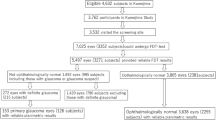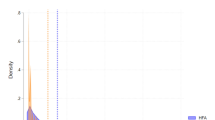Abstract
Purpose
To evaluate the learning effect of frequency doubling technology (FDT) perimetry using the Humphrey Matrix perimeter in healthy subjects with no perimetric experience.
Methods
One eye of 28 healthy adults who had no history of visual field testing underwent three Matrix tests using 24-2 programme with full-threshold strategy. The results of the first session were compared with those of the second, and the third sessions. Learning effect was defined as an improvement at results for duration, perimetric indices, and the number of points with a P<5 and <1% in the total and pattern deviation maps. Anderson's criteria were applied to define abnormal examinations.
Results
The mean in the mean deviation global index was −7.40±1.49 dB in the first session, −4.64±0.97 dB in the second session, and −3.29±0.93 dB in the third session. Pattern standard deviations were decreased as the tests were repeated (P<0.01). Test duration, fixation losses, false negative, and the number of points with a P<5 and <1% in the total and pattern deviation maps rate were also changed significantly (P<0.05). Among the criteria suggested by Anderson, the Glaucoma Hemifield Test performed better in all session tests. The false-positive rates ranged from 50% (95% confidence intervals [CI] 30.6–69.4%) to 64% (95% CI 44.1–81.4%) for the first session, 29% (95% CI 13.2–48.7%) to 54% (95% CI 33.9–72.5%) for the second session, and from 18% (95% CI 6.1–36.9%) to 32% (95% CI 15.9–52.4%) for the third session.
Conclusions
The results of this study show that the learning effect for Humphrey Matrix FDT perimetry must be considered in normal individuals with no perimetric experience.
Similar content being viewed by others
Log in or create a free account to read this content
Gain free access to this article, as well as selected content from this journal and more on nature.com
or
References
Quigley HA, Broman AT . The number of people with glaucoma worldwide in 2010 and 2020. Br J Ophthalmol 2006; 90 (3): 262–267.
Medeiros FA, Zangwill LM, Bowd C, Weinreb RN . Comparison of the GDx CCC scanning laser polarimeter, HRT II confocal scanning laser ophthalmoscope, and stratus OCT optical coherence tomography for the detection of glaucoma. Arch Ophthalmol 2004; 122 (6): 827–837.
Kelly DH . Frequency doubling in visual responses. J Opt Soc Am 1966; 56: 1628–1633.
Kelly DH . Nonlinear visual responses to flickering sinusoidal gratings. J Opt Soc Am 1981; 71 (9): 1051–1055.
Hong S, Ahn H, Ha SJ, Yeom HY, Seong GJ, Hong YJ . Early glaucoma detection using the Humphrey matrix Perimeter, GDx VCC, Stratus OCT, and retinal nerve fiber layer photography. Ophthalmology 2007; 114 (2): 210–215.
Wu LL, Suzuki Y, Kunimatsu S, Araie M, Iwase A, Tomita G . Frequency doubling technology and confocal scanning ophthalmoscopic optic disc analysis in open-angle glaucoma with hemifield defects. J Glaucoma 2001; 10 (4): 256–260.
Medeiros FA, Sample PA, Weinreb RN . Frequency-doubling technology perimetry abnormalities as predictors of visual field loss. Am J Ophthalmol 2004; 137 (5): 863–871.
Turpin A, McKendrick AM, Johnson CA, Vingrys AJ . Properties of perimetric threshold estimates from full threshold, ZEST, and SITA-like strategies, as determined by computer simulation. Invest Ophthalmol Vis Sci 2003; 44 (11): 4787–4795.
Heijl A, Krakau CE . An automatic static perimeter, design and pilot study. Acta Ophthalmol 1975; 53 (3): 293–310.
Spry PG, Johnson CA . Within-test variability of frequency-doubling perimetry using 24-2 test pattern. J Glaucoma 2002; 11 (4): 315–320.
Anderson AJ, Johnson CA, Fingeret M, Keltner JL, Spry PG, Wall M et al. Characteristics of the normative database for the Humphrey matrix perimeter. Invest Ophthalmol Vis Sci 2005; 46 (4): 1540–1548.
Heijl A, Lindgren G, Olsson J . The effect of perimetric experience in normal subjects. Arch Ophthalmol 1989; 107 (1): 81–86.
Pierre-Filho PT, Schimiti RB, Vasconcellos JP, Costa VP . Sensitivity and specificity of frequency-doubling technology, tendency-oriented perimetry, SITA Standard and SITA Fast perimetry in perimetrically inexperienced individuals. Acta Ophthalmol Scand 2006; 84 (3): 345–350.
Heijl A, Bengtsson B . The effect of perimetric experience in patients with glaucoma. Arch Ophthalmol 1996; 114 (1): 19–22.
Werner EB, Krupin T, Adelson A, Feitl ME . Effect of patient experience on the results of automated perimetry in glaucoma suspect patients. Ophthalmology 1990; 97 (1): 44–48.
Schimiti RB, Avelino RR, Kara-José N, Costa VP . Full-threshold vs Swedish Interactive Threshold Algorithm (SITA) in normal individuals undergoing automated perimetry for the first time. Ophthalmology 2002; 109 (11): 2084–2092; discussion 2092.
Wild JM, Moss ID . Baseline alterations in blue-on-yellow normal perimetric sensitivity. Graefes Arch Clin Exp Ophthalmol 1996; 234 (3): 141–149.
Rosseti L, Fogagnolo P, Miglior S, Centofanti M, Vetrugno M, Orzalesi N . Learning effect of short-wavelength automated perimetry in patients with ocular hypertension. J Glaucoma 2006; 15 (5): 399–404.
Bernardi L, Costa VP, Shiroma LO . Flicker perimetry in healthy subjects: influence of age and gender, learning effect and short term fluctuation. Arq Bras Oftalmol 2007; 70 (1): 91–99.
Horani A, Frenkel S, Yahalom C, Farber MD, Ticho U, Blumenthal EZ . The learning effect in visual field testing of healthy subjects using frequency doubling technology. J Glaucoma 2002; 11 (6): 511–516.
Hong S, Na K, Kim CY, Seong GJ . Learning effect of Humphrey matrix perimetry. Can J Ophthalmol 2007; 42 (5): 707–711.
Centofanti M, Fogagnolo P, Oddone F, Orzalesi N, Vetrugno M, Manni G et al. Learning effect of humphrey matrix frequency doubling technology perimetry in patients with ocular hypertension. J Glaucoma 2008; 17 (6): 436–441.
Contestabile MT, Perdicchi A, Amodeo S, Recupero V, Recupero SM . The influence of learning effect on frequency doubling technology perimetry (Matrix). J Glaucoma 2007; 16 (3): 297–301.
Artes PH, Hutchinson DM, Nicolela MT, LeBlanc RP, Chauhan BC . Threshold and variability properties of matrix frequency doubling technology and standard automated perimetry in glaucoma. Invest Ophthalmol Vis Sci 2005; 46 (7): 2451–2457.
Anderson DR, Patella VM . Automated Static Perimetry. Mosby: St Louis, MO, 1992, pp 10–35.
Anderson AJ, Johnson CA . Frequency-doubling technology perimetry. Ophthalmol Clin North Am 2003; 16 (2): 213–225.
Spry PG, Hussin HM, Sparrow JM . Clinical evaluation of frequency doubling technology perimetry using the Humphrey Matrix 24-2 threshold strategy. Br J Ophthalmol 2005; 89 (8): 1031–1035.
Burganski-Eliash Z, Wollstein G, Patel A, Bilonick RA, Ishikawa H, Kagemann L et al. Glaucoma detection with matrix and standard achromatic perimetry. Br J Ophthalmol 2007; 91 (7): 933–938.
Iester M, Capris P, Pandolfo A, Zingirian M, Traverso CE . Learning effect, short-term fluctuation, and long-term fluctuation in frequency doubling technique. Am J Ophthalmol 2000; 130 (2): 160–164.
Fujimoto N, Minowa K, Miyauchi O, Hanawa T, Adachi-Usami E . Learning effect for frequency doubling perimetry in patients with glaucoma. Am J Ophthalmol 2002; 133 (2): 69–270.
Johnson CA, Cioffi GA, Van Buskirk EM . Frequency doubling technology perimetry using a 24-2 stimulus presentation pattern. Optom Vis Sci 1999; 76 (8): 571–581.
Joson PJ, Kamantigue ME, Chen PP . Learning effects among perimetric novices in frequency doubling technology perimetry. Ophthalmology 2002; 109 (4): 757–760.
Author information
Authors and Affiliations
Corresponding author
Ethics declarations
Competing interests
The authors declare no conflict of interest.
Rights and permissions
About this article
Cite this article
Pierre-Filho, P., Gomes, P., Pierre, E. et al. Learning effect in visual field testing of healthy subjects using Humphrey Matrix frequency doubling technology perimetry. Eye 24, 851–856 (2010). https://doi.org/10.1038/eye.2009.210
Received:
Revised:
Accepted:
Published:
Issue date:
DOI: https://doi.org/10.1038/eye.2009.210



